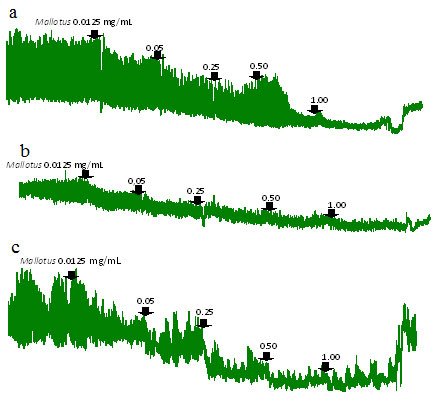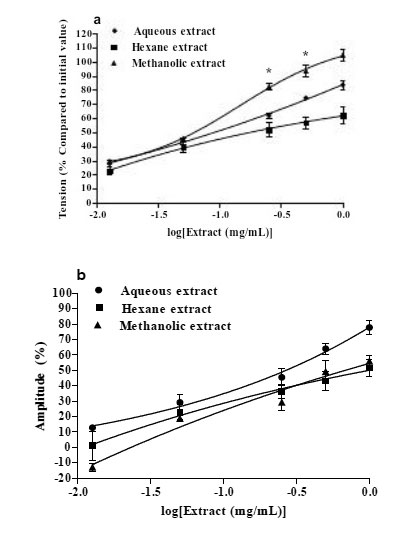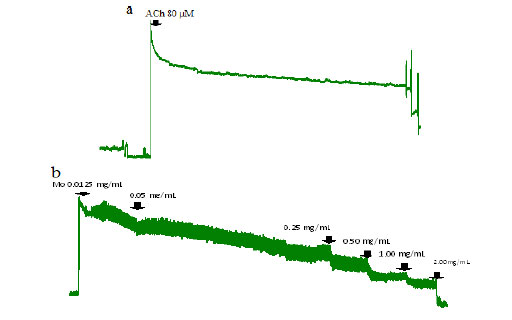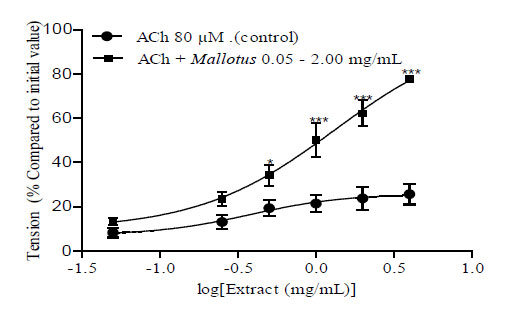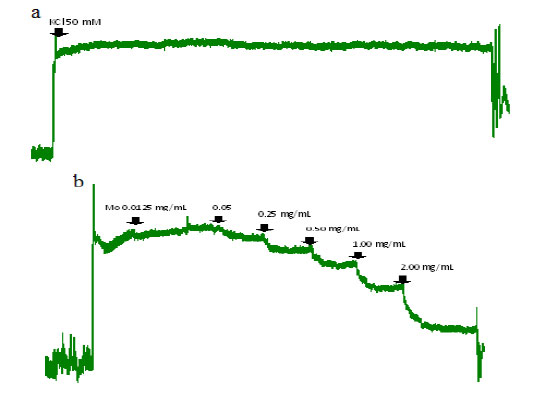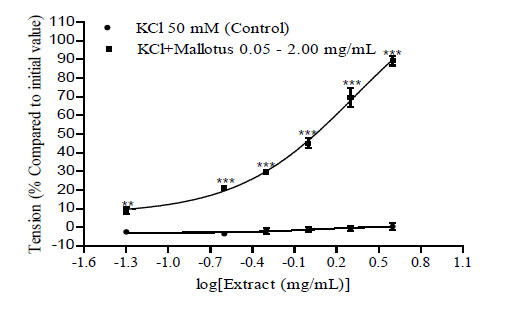
Japanese Journal of Gastroenterology Research
Research Article - Open Access, Volume 1
In vitro antispasmodic effects of Mallotus oppositifolium leaves extracts
Roger Zintchem1,2; Paul Aimé Noubissi3*; Michel Archange Fokam Tagne4; Joseph Njiaza1; Gaétan Olivier Fankem1; Joseph Ngakou Mukam1; Angèle Fondjo Foyet5; Claude Bernard Bidias6; Charles Fokunang7; René Kamgang1,8
1Animal Physiology Laboratory, Department of Biology and Animal Physiology, Faculty of Science, University of Yaoundé I, Yaoundé, Cameroon.
2Laboratory of Educations and Health Practices, Nursing Sciences Research Chair, Sorbonne Paris Nord University; (EA 3412), UFR SMBH, F-93017, Bobigny, France Avicenne-Jean Verdier Nursing Training Institute, CFDC, Assistance Publique-Hôpitaux de Paris, F-93000, Bobigny, France.
3Department of Zoology and Animal Physiology, Faculty of Science, University of Buea, Buea, Cameroon.
4Department of Biological Science, Faculty of Science, University of Ngaoundéré, Ngaoundéré, Cameroon.
5Department of Applied Sciences for Health, Higher Institute of Applied Sciences, University Institute of Gulf of Guinea, Douala, Cameroon.
6VIPOD, Medical Research Departement, Yaoundé Cameroon.
7Department of Pharmacotoxicology and Pharmacokinetics, Faculty of Medicine and Biomedical Sciences, University of Yaoundé I, Yaoundé, Cameroon.
8Laboratory of Endocrinology and Radioisotopes, Institute of Medical Research and Medicinal Plants Studies (IMPM), Yaoundé, Cameroon.
*Corresponding Author: Paul Aimé NOUBISSI
Department of Zoology and Animal Physiology, Faculty of Science, University of Buea, 63, Buea, Cameroon.
Tel: +237-675-31-31-98;
Email: noubiaime@yahoo.fr
Received : Sep 17, 2021
Accepted : Oct 26, 2021
Published : Oct 29, 2021
Archived : www.jjgastro.com
Copyright : © NOUBISSI PA (2021).
Abstract
Mallotus oppositifolium is a plant traditionally used in many African countries to treat diarrhea and other gastrointestinal tract disorders. This study was undertaken to evaluate in vitro antispasmodic effects of decoction, hexane and methanolic leaves extracts of this plant. Antispasmodic activities of Mallotus oppositifolium leaves decoction, hexane and methanolic extracts were assessed on spontaneous contractions, on acetylcholine or potassium chloride (KCl) induced contractions of isolated rat duodenum strips. Mallotus oppositifolium decoction, hexane or methanolic extracts increasing cumulative concentrations relaxed duodenum strips and at 1 mg/mL, they respectively decreased contraction amplitudes by 77.84 ± 2.25, 55.81 ± 2.14, and 51.67 ± 0.95% compared to the initial values. Decoction, hexane, and methanolic extracts decreased contraction tensions respectively from 3.00 to 2.5 gF, 3.40 to 2.80 gF and from 3.10 to 2.50 gF. At 0.25 mg/mL, they significantly (p <0.05) decreased contraction tension. Emax were 186.89 ± 34.05, 116.30 ± 10.92 and 91.57 ± 4.70% respectively with decoction, methanolic, and hexane extracts with EC50 of 0.610 ± 0.184; 0.146 ± 0.011 and 0.237 ± 0.105 mg/mL (p <0.05). Acetylcholine increased contraction amplitudes. Cumulative administration of Mallotus oppositifolium decoction at 0.05 to 2.00 mg/mL significantly (p <0.05) decreased tension, from 4.00 to 2.60 g.F. At these concentrations, tension variation was concentration-dependent, it increased from 13.39 ± 1.72 to 77.59 ± 1.10%. EC50 and Emax were respectively 1.311 ± 0.340 mg/mL and 99.29 ± 24.80%. KCl produced only little variations of contractions amplitude. Emax was 0.65%. Cumulative administration of Mallotus oppositifolium decoction from 0.05 to 2.00 mg/mL significantly (p <0.05) decreased KCl induced contraction tension, from 3.70 to 2.30 gF (p <0.05). Emax was 133.30 ± 34.29% and EC50 = 2.140 ± 0.231 mg/mL. The antispasmodic effects of Mallotus oppositifolium extracts obtained in this study could therefore justify its traditional use against gastrointestinal tract ailments.
Keywords: mallotus oppositifolium; acetylcholine; potassium chloride; antispasmodic effects; gastrointestinal tract disorders.
Citation:Zintchem R, Noubissi PA, Fokam Tagne MA, Njiaza J, Fankem GO. In vitro antispasmodic effects of Mallotus oppositifolium leaves extracts. Japanese J Gastroenterol Res. 2021; 1(6): 1029.
Introduction
In the southern countries biodiversity, plants are sources of traditional remedies that 80% of the population relies on, at least, for the treatment of the poverty related diseases [1] or in primary health care [2,3]. The discovery of antibiotics in 1928 provides efficient therapeutic agents against infectious diseases, leading causes of death, especially in those countries [4]. But the clinical efficacy of many antibiotics is threatened by the emergence of multi-drug resistant pathogens enhanced by them [5]. Reason why WHO recommends evaluations of the quality, safety and efficacy of the medicinal plants through modern technics, looking for new leads to develop better drugs against microbial infections. That is the case with Mallotus oppositifolium (Euphorbiaceae) which has been locally used to treat many diseases in Cameroon and the other equatorial and tropical countries of Africa. In those Regions, different parts of the plant are used in the management of affections such as helminthiasis, gastro-intestinal disorder like dysentery and acute diarrhea [6]. The leaves have several properties against diabetes, convulsions and epilepsy [7]. Anti-inflammatory [8], and antioxidant effects [9, 10] of the plant have been carried out. The present study was undertaken to evaluate effects of decoction, hexane and methanolic extracts of Mallotus oppositifolium leaves on duodenum strips spontaneous contractions as well as on acetylcholine or potassium chloride duodenum-induced contractions.
Materials and methods
Plant material and preparation of the extract and fractions
Mallotus oppositifolium leaves were collected from the Gouife-Bep village (Bafia-Cameroon) on October 2012. The species was identified and authenticated in the National Herbarium of Cameroon by comparison with a voucher specimen deposited under the number HNC 16619. The leaves were thoroughly rinsed twice in running tap water and then in sterile water before being air-dried for 2 weeks at room temperature (22-26°C). The dried leaves were powdered into a fine texture using an electric blender and kept in polyethylene bags ready for extraction.
Mallotus oppositifolium leaves aqueous extract (decoction)
Mallotus oppositifolium leaves powder (500 g) was macerated in 5 L of distilled water for two hours. The macerate was boiled (15 min) in a water bath and then, first filtered through cotton and subsequently using Whatman No. 1 filter paper. The filtrate obtained, a semi-solid Mallotus oppositifolium extract solution of brown and homogeneous color was concentrated in a rotary evaporator at 40-45°C to obtain 28.6 g (5.72%) of decoction (DEMO).
Mallotus oppositifolium hexane and methanol extract
Mallotus oppositifolium leaves powder (500 g X 2) was macerated respectively in 5 L of methanol or in 5 L of hexane to obtain methanol (MEMO) or hexane (HEMO) filtrates which were then concentrated to 200 millibars in rotary evaporators at 40°C for the methanol or at 45°C for the hexane filtrates, to respectively obtain 29.6 g (5.92%) of methanolic extract (MEMO) or 27.3 (5.46%) of hexane extract (HEMO).
Experimental animals
The experiments were carried out on Wistar albino rats of both sexes, reared at room temperature, with sufficient aeration, in animal house of the Institute for Medical Research and Study of Medicinal Plants (IMPM) and at the Faculty of Medicine and Biomedical Sciences (FMSB) of the University of Yaounde I. Animals ad libitum had access to tap water supplemented with a few drops of vitamin B complex (5 drops per liter). Their diet was made up of a mixture of corn flour (60%), wheat (10%), fish (12%), soybean (15%) and 3% red oil [11].
Experimentation
Effects of Mallotus oppositifolium extracts on rat isolated duodenum fragments spontaneous contractions
Reagents and experimental physiological solution
Effects of M. oppositifolium aqueous, hexane or methanol extracts were evaluated on duodenum motility with the aid of an organ bath (20 mL) containing Tyrode's physiological solution. Its composition in mM (NaCl 136.90; Glucose 5.55; NaHCO3 11.90; CaCl2 1.87; KCl 2.68; MgCl2 1.05, and NaH2PO4 0.42) is suitable to maintain alive duodenum strips [12]. Experiments were carried out on normal and on Acetylcholine or Potassium Chloride-precontracted duodenum strips. Stock solutions were prepared by dissolving 3.05 mg of acetylcholine chloride (SIGMA Chemical Co., ST Louis, USA) in 134 mL of distilled water. (80 μM) or 746 mg of Potassium Chloride salt in 5 mL of distilled water (50 mM).
Administration of any substance in the bath was preceded by a certain volume of Tyrode's solution which thereafter was adjusted to 20 mL with the corresponding volume of the said substance. The final concentration of drugs in the bath was determined according to the dilution formula:

- IC the initial concentration of the substance to be administered;
- IV the initial volume of the substance to be administered;
- FC the final concentration of the substance in Tyrode's liquid;
- FV the final volume of the bath (20 mL)
In our study, from stock extract solutions of a concentration of 100 mg/mL, final extract concentrations of 0.0125, 0.05, 0.25, 0.50, 1.00, 2.00, and 4.00 mg/mL were tested by, respectively, adding into the organ bath 0.0062, 0.125, 0.025, 0.05, 0.10, and 0.2 mL of the stock solutions.
Experimental design
Rats were fasted for 24 h before the experiments with free access to water. Then they were sacrificed by cervical dislocation, the abdomens were cut open and the duodenal portions were isolated. Preparations of about 2 cm long were mounted in 20 mL tissue baths containing Tyrode's solution maintained at 37°C, constantly aerated with carbogen (a mixture of 5% carbon dioxide in oxygen). Tension of about 1.0 gF of preload was applied to tissues and subsequently kept undisturbed for one hour for stabilization.
The registration section was made up of a Student Lab software connected to the acquisition system (Biopac MP 35), equipped with an isometric transducer which transformed the mechanical contractile activity of the smooth muscles of the intestinal fragment into electric signals; visualized through a computer.
Evaluation of different extracts of Mallotus oppositifolium on rats duodenum spontaneous contractions
Spontaneous contractions of duodenum fragments in organ bath were observed during 60 min in order to obtain an approximately constant amplitude, frequency and tone (stabilization). During this stabilization process, Tyrode's solution in the organ bath was replaced every 15 min after which a tension of 1 g.F was applied to the organ.
The first serie of experiments was carried out to evaluate effects of different extracts of M. oppositifolium (decoction, methanolic, hexane) in increasing concentrations (0.0125 to 2 mg/mL) on duodenum contractions. After stabilization, a certain volume of extract solution was added into the organ bath and its effects on spontaneous contractions were observed over a period of 20 min. The organ was then washed 3 to 4 times with fresh Tyrode's solution and left for complete recovery for 60 min before being resubjected to a second series of the same extract concentrations as previously done. The effects on rat duodenum contractions were evaluated in at final concentrations of 0.0125, 0.05, 0.25, 0.50, 1.00, and 2.00 mg/mL. Distilled water was used as control. The concentration-response curve of the extract was obtained from a non-linear regression using GraphPad Prism software version 5.03. The extract concentration which caused half of the maximum effect (EC50), as well as extract concentration which caused the maximum effect (Emax) were determined [13,14].
The effects of M. oppositifolium extracts were also evaluated on the parameters of contractions, such as amplitude, and basic tension.
Evaluation of the effects of Mallotus oppositifolium extracts on variations of amplitude of spontaneous contractions
Contraction amplitudes were recorded before (ampl. T0) and after application of extracts (ampl. Ti). After administration of the extract, amplitude of contractions was recorded every 2 min for 20 min and the contraction amplitude variation (in percentage) was calculated as follow [13,14]:

ampl.T0 = mean amplitude before administration of the extract
ampl.Ti = amplitude at a specific time after administration of the extract
Evaluation of the effects of Mallotus oppositifolium extracts on spontaneous contraction basic tension
The initial tension mean (T0) is the basic tension recorded before extract administration. Tension variation (in percentage) was expressed according to the initial tension mean as follows [13,14]:

T0 = initial tension mean (average of minimum tensions before extract administration)
Ti = minimum tenion of the duodenum segments recorded for 2 min
Tm = minimum tension of the duodenum segments during the 20 min of experimentation
After extract administration, basic contractions tensions were recorded every two minutes during the 20 min of experimentation.
Investigation among local population reveals that decoction of the plant was orally taken in the management of diarrheal syndromes. Moreover, preliminary results did not show great difference between the effects of the different extracts. In addition, the methanol and hexane used for the said extracts could be harmful to the body. Hence, we choose the decoction for further evaluation of their antidiarrheal properties of this plant.
Evaluation of the effects of Mallotus oppositifolium decoction on acetylcholine or potassium chloride-induced duodenum contraction
Effects of Mallotus oppositifolium aqueous extract were evaluated on acetylcholine or potassium chloride induced duodenum contraction. Each duodenum segment was mounted in the organ bath containing 15 mL of Tyrode's solution maintained at 37°C and continuously ventilated with a mixture of 95% oxygen and 5% carbon dioxide (carbogen). Duodenum segments were left in calibration and stabilization for 60 min before any drug administration. Acetylcholine (80 μM) was then injected into the organ bath to induce muscle contraction. Once the tension of the contraction was stable, every 5 min, Mallotus oppositifolium aqueous extract was added to the incubation medium at cumulative concentrations ranging from 0.0125 to 2.00 mg/mL. A concentration-response curve of extract effects was obtained; the median effective concentration (EC50) and maximum muscle relaxant effect (Emax) were determined.
Under the same experimental conditions, Mallotus opposifolium aqueous extract effects were evaluated on potassium chloride (50 mM) induced contraction. After calibration and stabilization of duodenum segments, KCl solution was injected into the organ bath (at a volume corresponding to a final concentration of 50 mM). Once the contraction was stable, every 5 min, Mallotus oppositifolium aqueous extract was added to the incubation medium at cumulative concentrations ranging from 0.0125 to 2.00 mg/mL. From the concentration-response curve, the median effective concentration (EC50) and maximum muscle relaxant effect (Emax) were determined [12].
Statistical analysis and presentation of results
Results were expressed as Mean ± Standard Error of the Mean (SEM) of several reproduced tests. Duodenum motility, changes in amplitude and tension of contractions were assessed and expressed in percentage compared to their initial values. Graph Pad Prism software version 5.03 (GraphPad Software, San Diego, California, USA) was used to perform statistical analysis. Statistical differences between control and treated groups were tested by a one-way analysis of variance (ANOVA), followed by Tukey's multiple comparison test. Values of p <0.05 were considered statistically significant.
Results
Effects of Mallotus oppositifolium extracts on rat duodenum spontaneous activity
Spontaneous contractions of the rat duodenum (Figure 1) are oscillations of more or less variable tension and amplitude, characteristic of intestine peristalsis.
Administration of increasing cumulative concentrations (0.0125, 0.05, 0.25, 0.50 and 1.00 mg/mL) of M. oppositifolium aqueous, hexane and methanol extracts in the incubation bath produced relaxation of duodenum segments. Aqueous, methanol, and hexane extracts at 0.0125 mg/mL decreased contraction amplitudes respectively by 12.71 ± 1.05 (Figures 2a), 1.09 ± 0.04 (Figures 2b), and 13.07 ± 1.61% (Figures 2c). At 1 mg/mL, these extracts, decreased contraction amplitudes respectively by 77.84 ± 2.25% (Figure 2a), 55.81 ± 2.14% (Figure 2b) and 51.67 ± 0.95% (Figure 2c) compared to the initial values.
Cumulative extract concentrations (0.0125 to 1 mg/mL) decreased in a dose-dependent way, tension of duodenum contractions. Treated with M. oppositifolium aqueous, hexane, and methanolic extracts, tensions respectively went from 3.00 to 2.5 gF, 3.40 to 2.80 gF and from 3.10 to 2.50 gF (Figure 3a). M. oppositifolium aqueous, hexane and methanolic extracts at 0.25 mg/mL, significantly (p <0.05) decreased contraction tension and the decrease percentages were respectively 82.65 ± 5.40, 62.00 ± 2.06, and 52.06 ± 1.50%. At 1 mg/mL, these percentages were respectively 83.87 ± 3.15, 62.53 ± 5.85, and 104.90 ± 4.04% (p <0.05). Maximum muscle relaxant effects (Emax) observed were 186.89 ± 34.05, 116.30 ± 10.92 and 91.57 ± 4.70% respectively with aqueous, methanolic, and hexane extracts. Extract concentrations causing 50% muscle relaxation (Figure 3b) or median effective concentrations (EC50) were respectively 0.610± 0.184; 0.146 ± 0.011 and 0.237 ± 0.105 mg/mL (p <0.05) for the three extracts. The relaxating effect of M. opposifolium extracts was stable after 2-3 recordings indicating that it was not a toxic effect.
Effects of Mallotus oppositifolium decoction on acetylcholine-induced duodenum contractions
Administration of a single dose of acetylcholine (ACh), 80 μM in the incubation bath caused rapid phasic contraction followed by a slowly decreasing tension. ACh at this concentration, induced an increase of contraction amplitudes which further gradually decreased. Tension increased, due to Ach from 4.20 to 5.00 gF (Figure 4a) corresponding to an increase of 25.68 ± 1.50%, compared to 8.25 ± 2.09% in the control treated with distilled water (Figure 4b). Cumulative administration of M. oppositifolium aqueous extract from 0.05 to 2.00 mg/mL caused a significant (p <0.05) decrease of tension, from 4.00 to 2.60 gF. At these extract concentrations, tension variation of spontaneous contractions was concentration-dependent and it increased from 13.39 ± 1.72 to 77.59 ± 1.10%. Median effective concentration (EC50) and the maximum muscle relaxant effect (Emax) of the extract, determined from the analysis of the concentration–response curves were respectively 1.311 ± 0.340 mg/mL and 99.29 ± 24.80% (Figure 5).
Effects of Mallotus oppositifolium decoction Potassium chloride -induced duodenum contractions
Administration of 50 mM KCl in the incubation organ bath medium caused a rapid phasic contraction followed by a slow stabilizing tension (Figure 6a). Amplitude of these contractions showed only little variations, while tension increased from 2.30 to 8.50 gF and remained constant at this level. The maximum muscle relaxant effect of KCl at this dose was 0.65%. Cumulative administration of M. oppositifolium aqueous extract from 0.0125 to 2.00 mg/mL caused a significant (p <0.001) decrease of concentrations tension induced by the 50 mM KCl. Tension with KCl went from 3.70 to 12.30 gF (Figure 6b), M. oppositifolium aqueous extract at 2.00 mg/mL significantly (p <0.001) decreased tension to 9.00 gF. The maximum relaxant effect of Mallotus oppositifolium aqueous extract was Emax=133.30 ± 34.29% and its median effective concentration EC50 = 2.140 ± 0.231 mg/mL (Figure 7).
Discussion
Mallotus oppositifolium (Euphorbiaceae) has been used in Cameroon and other equatorial and tropical countries of Africa to treat many diseases. In those Regions, different parts of the plant are used in the management of affections such as helminthiasis, gastro-intestinal disorder like dysentery and acute diarrhea [6]. The leaves have several properties against diabetes, convulsions and epilepsy [7]. Anti-inflammatory [8], and antioxidant effects [9,10] of the plant have been carried out. The present study was undertaken to evaluated effects of decoction, hexane and methanolic Mallotus oppositifolium leaves extracts on duodenum strips spontaneous contractions as well as on acetylcholine or potassium chloride duodenum-induced contractions.
The duodenum is the initial portion of the small intestine and is where absorption actually begins. The duodenal wall has two regions of muscle tissue, the muscularis externa and the muscularis mucosa. The muscularis externa consists of an outer longitudinal layer and an inner circular layer and is the major effector of mixing and propulsion. The myenteric plexus of Auerbach lies between these two layers and with the Meissner plexus they constitute the enteric nervous system [15]. Uncontrolled contractions of these muscles can lead to diarrheal diseases, a serious major public health problem in developing countries [16]. Diarrhea is an intestinal disorders and/or infections characterized by the passage of three or more loose and/or liquid stools daily [17]. It remains one of the leading causes of morbidity and mortality in developing countries [18]. Diarrhea is a consequence of an increased intestinal motility and/or secretion, a decreased fluid absorption leading to increased stools fluidity, volume and frequency, ad resulting to excessive body water and electrolytes [19].
Motor diarrhea results from acceleration of gastrointestinal transit by endocrine or nerve stimulations. These stimulations result to action potentials which trigger contractions of smooth intestine muscle fibers [20, 21]. These contractions or spasms are characterized by an increase tension, amplitude and frequency, leading to motor diarrhea [21].
Contractions of intestine smooth muscles are initiated by phosphorylation of the 20 kDa regulatory subunit of the myosin light chains(MLC20) by Ca2+/calmodulin-dependent myosin light chain kinase or Ca2+-independent kinases [22]. An increasing level of cytoplasmic Ca2+ ([Ca2+]i) is the main physiological event that activates myosin light chain kinase. Phosphorylation of MLC20 facilitates myosin binding to actin, initiating cross-bridge cycling and force development. Neurotransmitters such as Acetylcholine (ACh) and potassium salts such as Potassium Chloride (KCl) are potential muscle contraction stimulators, which can accelerate intestinal transit and thus, causing diarrheal syndromes. Aqueous, hexane and methanol extracts of M. oppositifolium decreased amplitude and tension of rat duodenum spontaneous contractions. Administration of acetylcholine (ACh) in this organ bath caused a rapid phasic contraction followed by a tonic contraction which decreased slowly. Ach is released by the parasympathetic nervous system and is involved in the physiological regulation of intestinal transit [23]. Acetylcholine induces intestinal smooth muscle contractions through a double mechanism coupled to muscarinic receptors: one of the mechanisms is the non-selective activation of cation channels leading to membrane depolarization and calcium influx via voltage-gated calcium channels [24]. The other mechanism is the release of intracellular calcium from sarcoplasmic reticulum. The ability of M. oppositifolium extract to inhibit spontaneous or acetylcholine-induced contractions, indicates that the plant has anti-diarrheal effects through its myorelaxant activity [25]. Administration of Potassium Chloride in the incubation medium produced a sustained rapid phasic contraction followed by a slow tonic contraction whose tone was concentration-dependent inhibited by Mallotus oppositifolium decoction. A high extracellular concentration of K+ stimulates the opening of voltage-gated calcium channels, thus inducing the extracellular calcium influx leading to contractions [26, 27]. The ability of M. oppositifolium extract to inhibit normal spontaneous duodenal contractions and those induced by KCl shows that the plant would have antidiarrheal effects through its muscle relaxant activity on spontaneous duodenal contractions.
Qualitative and quantitative phytochemical studies revealed the presence of bioactive metabolites such as tannins, alkaloids, saponins, flavonoids, anthraquinones, steroids and/or terpenoids whose anti-diarrheal effects have been demonstrated [28,29]. Flavonoïds, and tannins are generally responsible for myorelaxant properties of medicinal plants [29]. Further more, flavonoïds showed their ability to inhibit contractions induced by spasmogens as well as to reduce the amplitudes of intestine contractions through inhibition of acetylcholine secretion [30].
Conclusion
Based on the results, it can be concluded that the Mallotus oppositifolium both leaves decoction and hexane or methanolic extracts have myorelaxant properties probably through inhibition of acetylcholine release or its activities. Mallotus oppositifolium therefore, constitutes a potential candidate for the development of traditional improved medicines for the management and control of gastrointestinal disorders, especially diarrhea. Future work is needed to isolate and characterize pure compounds which sustain these pharmacological activities.
Declarations
Conflicts of interest: The authors declare that they have no known competing financial interests or personal relationships that could have appeared to influence the work reported in this paper.
Acknowledgements: The authors wish to thank the Departments of Organic Chemistry of the Faculty of Science of the University of Yaounde I for plant methanol and hexane fractions preparation. We also thank the GEMS (General Endocrinology and Metabolic System) team of the Department of Biology and Animal Physiology of the Faculty of Science-University of Yaounde I for their facilities, also for the many expert reviews that made critical comments to improve this manuscript.
References
- Tripathi L, Tripathi JN. Role of biotechnology in medicinal plants. Trop. J. Pharm. Res. 2003; 2(2): 243–253.
- Sule WF, et al. In vitro antifungal activity of Senna alata Linn. rude leaf extract. Res. J. Biol. Sci. 2010; 5(3): 275–284.
- W. H. O. (WHO), WHO Global report on traditional and complementary medicine 2019. 2019.
- Chanda S, Rakholiya K. Combination therapy : Synergism between natural plant extracts and antibiotics against infectious diseases. Sci. against Microb. Pathog. Commun. Curr. Res. Technol. Adv. A. Méndez-Vilas. 2011; 20: 520–529.
- Barbour EK, Al Sharif M, Sagherian VK, Habre AN, Talhouk RS, Talhouk SN. Screening of selected indigenous plants of Lebanon for antimicrobial activity. J. Ethnopharmacol. 2004; 93(1): 1–7.
- Zintchem R, et al. In vitro evaluation of the antimicrobial properties of Mallotus oppositifolium decoction leaf extracts and fractions. Int. J. Biol. Chem. Sci. 2015; 9(2): 815–824.
- Kukuia KKE, Ameyaw EO, Mante PK, Adongo DW, Woode E. Screening of central effects of the leaves of Mallotus oppositifolius (Geiseler) Mull. Arg. in mice. Pharmacologia. 2012; 3(12): 683–692.
- Nwaehujor CO, Ezeigbo II, Nwinyi FC. Evaluation of Mallotus oppositifolius methanol leaf extract on the glycaemia and lipid peroxidation in alloxan-induced diabetic rats: A preliminary study. Biochem. Res. Int. 2013; 2013: 1–6.
- Adedara I, Adesanoye O, Farombi E. Evaluation of antioxidant properties of Mallotus oppositifolium in in-vitro, in-vivo and ex-vivo model systems. Afr. J. Med. Med. Sci. 2010; 39: 67–72.
- Zintchem R, Njinkio B, Kamgang R, Fokunang C, Tsala D, Biwole Sida M. Antioxidative properties of Mallotus oppositifolium decoction leaves extract using in vitro models. Int. J. Biol. Chem. Sci. 2013; 7(6): 2396–2408.
- Kamgang R, Youmbi Mboumi R, Foyet Fondjo A, Fokam Tagne MA, Mengue N'dillé G, Ngongang Yonkeu J. Antihyperglycemicpotential of the water-ethanol extract of Kalanchoe crenata. J. Nat. Med. 2008; 62: 34-40.
- Gilani AH, et al. Gastrointestinal, selective airways and urinary bladder relaxant effects of Hyoscyamus niger are mediated through dual blockade of muscarinic receptors and Ca2+ channels. Fundam. Clin. Pharmacol. 2008; 22(1): 87–99.
- Desire O, et al. Antispasmodic and antioxidant activities of fractions and bioactive constituent davidigenin isolated from Mascarenhasia arborescens. J. Ethnopharmacol. 2010; 130(2): 320–328.
- Njiaza J, et al. Effects of the aqueous extract of Pittosporum mannii Hook. f. (Pittosporaceae) stem barks on spontaneous and spasmogen-induced contractile activity of isolated rat duodenum. J. Ethnopharmacol. 2015; 172: 1–9.
- Shames B. Anatomy and Physiology of the Duodenum, Eighth Edi. Elsevier Inc., 2013.
- Noubissi PA, Fokam Tagne AM, Fankem GO, Ngakou Mukam J, Wambe H, Kamgang R. Effects of Crinum jagus water / ethanol extract on Shigella flexneri -induced diarrhea in rats. Evidence-Based Complement. Altern. Med. 2019; 2019: 1–10.
- Fokam Tagne MA, et al. Evaluation of antidiarrheal activity of aqueous leaf extract of Anogeissus leiocarpus on castor oil-induced diarrhea in rats. Am. J. Biomed. Sci. Res. 2019; 3(1): 27–34.
- Wambe H, et al. Anti-shigellosis activity of Cola anomala water/ethanol pods extract on Shigella flexneri-induced diarrhea in rats. Biomed Res. Int. 2019; 2019: 1–9.
- Ammoury RF, Ghishan FK. Pathophysiology of diarrhea and its clinical implications, First Edit. Elsevier Inc. 2012.
- Sheikh IA, Ammoury R, Ghishan FK. Pathophysiology of diarrhea and its clinical implications, Sixth Edit. Elsevier In. 2018.
- Hajagos-Tóth J, Falkay G, Gáspár R. Modification of the effect of nifedipine in the pregnant rat myometrium: The influence of progesterone and terbutaline. Life Sci. 2009; 85: 15–16.
- Sanders KM, Koh SD, Ro S, Ward SM. Regulation of gastrointestinal motility—insights from smooth muscle biology. Nat. Rev. Gastroenterol. Hepatol. 2016; 9(11): 635–645.
- Zdeňka Ďuračková. Some current insights into oxidative stress. Physiol. Res. 2010; 59: 459–469.
- Gupta RK, et al. Comparison of calcium dynamics and specific features for G protein–coupled receptor–targeting drugs using live cell imaging and automated analysis. SLAS Discov. 2017; 22(7): 848–858.
- Gilani AH, Mehmood MH, Janbaz KH, Ullah Khan A, Saeed SA. Ethnopharmacological studies on antispasmodic and antiplatelet activities of Ficus carica. J. Ethnopharmacol. 2008; 119(1): 1–5.
- Brankovic SV, Kitic DV, Radenkovic MM, Veljkovic SM, Golubovic TD. Calcium blocking activity as a mechanism of the spasmolytic effect of the essential oil of Calamintha glandulosa Silic on the isolated rat ileum. Gen. Physiol. Biophys. 2009; 28: 174–178.
- Teke GN, Kuiate JR, Kueté V, Teponno RB, Tapondjou LA, Vilarem G. Antidiarrheal activity of extracts and compound from Trilepisium madagascariense stem bark. Indian J. Pharmacol. 2010; 42(3) 157–163.
- Oben JE, Assi SE, Agbor GA, Musoro DF. Effect of Eremomastax speciosa on experimantal diarrhoea. Afr. J. Tradit. Complement. Altern. Med. 2006; 3(1): 95–100.
- Dosso K, Attemene Dago SD, Gboko AO, N'guessan BB, Yapo AP. Anticholinergic and adrenergic activities of a dichloromethane fraction of a crude ethanol extract of stem bark of Piliostigma reticulatum Horscht D.C (Ceasalpiniaceae). GSC Adv. Res. Rev. 2020; 3(1): 001–010.
- Venkatesan N, et al. Anti-diarrhoeal potential of Asparagus racemosus wild root extracts in laboratory animals. J. Pharm. Pharm. Sci. 2005; 8(1): 39–45.


